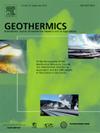数据驱动的球道分析应用于墨西哥Los Humeros地热田
IF 3.5
2区 工程技术
Q3 ENERGY & FUELS
引用次数: 0
摘要
利用已发表的地球科学数据,对墨西哥普埃布拉Los Humeros地热田进行了数据驱动的地热球道分析(PFA)。现有的数据集被认为是热液地热系统形成过程中必要要素(如渗透率、热量)的积极指标或替代指标(证据层)。以断裂、有利构造环境、CO2外排、地震、地表热液表现和土壤温度等数据为代表。使用证据权重统计方法将这些代理组合起来,以获得渗透率和热量的模型。然后,通过产品运算将渗透率和热量模型整合,建立整体地热有利度模型。地热有利度模型突出了四个地热有利度较高的区域,分别位于Los Humeros村的NNE、NNW、NE和南部。有利度较高的区域代表地热流体更有可能存在于地下的区域。这四个地区可能是进一步勘探的目标(例如探井),特别是Los Humeros村附近的D区。与A、B、C区相比,D区面积最大,开发程度较低,CO2和土壤温度异常最强。最后,提出了有利的构造环境对地热流体渗透带的位置起主要控制作用。本文章由计算机程序翻译,如有差异,请以英文原文为准。
Data-driven Play Fairway Analysis applied to Los Humeros geothermal field, Mexico
A data-driven geothermal Play Fairway Analysis (PFA) of the Los Humeros geothermal field in Puebla, Mexico was conducted using published geoscientific data. The available datasets considered as positive indicators or proxies (evidence layers) for the necessary elements in the formation of hydrothermal geothermal systems (e.g., permeability, heat) were weighted and integrated. The datasets used as proxies were faults, favorable structural settings, CO2 efflux, earthquakes, surficial hydrothermal manifestations and soil temperatures. The proxies were combined using weights-of-evidence statistics to obtain models for permeability and heat. Afterwards, the permeability and heat models were integrated through a product operation to build an overall geothermal favorability model. The geothermal favorability model highlights four areas with elevated geothermal favorability located to the NNE, NNW, NE, and south of the village of Los Humeros. The areas of higher favorability represent zones where geothermal fluids are more likely to exist underground. These four areas could represent targets for further exploration (e.g., exploration wells), particularly area D near the village of Los Humeros. Area D is the largest, it is underexploited (compared with areas A, B and C) and presents the strongest CO2 and soil temperatures anomalies. Finally, it is proposed that favorable structural settings exercise a primary control on the location of permeable zones with geothermal fluids.
求助全文
通过发布文献求助,成功后即可免费获取论文全文。
去求助
来源期刊

Geothermics
工程技术-地球科学综合
CiteScore
7.70
自引率
15.40%
发文量
237
审稿时长
4.5 months
期刊介绍:
Geothermics is an international journal devoted to the research and development of geothermal energy. The International Board of Editors of Geothermics, which comprises specialists in the various aspects of geothermal resources, exploration and development, guarantees the balanced, comprehensive view of scientific and technological developments in this promising energy field.
It promulgates the state of the art and science of geothermal energy, its exploration and exploitation through a regular exchange of information from all parts of the world. The journal publishes articles dealing with the theory, exploration techniques and all aspects of the utilization of geothermal resources. Geothermics serves as the scientific house, or exchange medium, through which the growing community of geothermal specialists can provide and receive information.
 求助内容:
求助内容: 应助结果提醒方式:
应助结果提醒方式:


